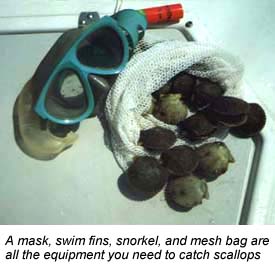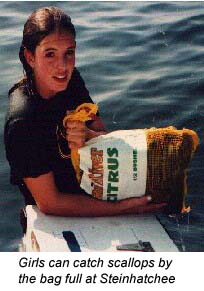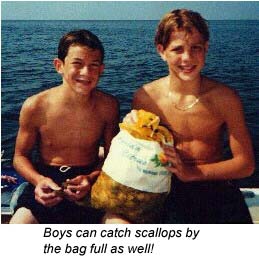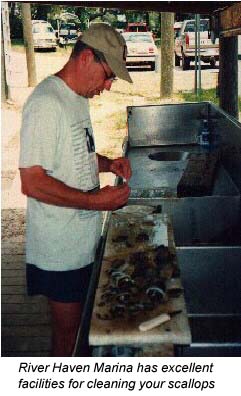Recreational Shrimping and Scalloping
by Charlie Courtney
When July and August roll around, the hot midday sun makes
fishing miserable in Big Bend waters. However Big Bend anglers
have two cooler alternatives that still let them harvest the
sea's bounty, scalloping and shrimping.
Get Your Own Scallops
 Scalloping is a cool activity in the midsummer's
heat because you actually get into the water and swim after them.
Scalloping out of Steinhatchee is very good at this time of
year. In fact this is the only time of year you can catch your
own scallops, since scallop season is open only from July 1 until
September 10 and only from the the Pasco/Hernando County line
to the Mexico Beach Canal. Scalloping is closed over the entire Florida
peninsula from the Georgia state line to the Pasco/Hernando County
Line and the Florida Panhandle west of the Mexico Beach Canal.
Scalloping is a cool activity in the midsummer's
heat because you actually get into the water and swim after them.
Scalloping out of Steinhatchee is very good at this time of
year. In fact this is the only time of year you can catch your
own scallops, since scallop season is open only from July 1 until
September 10 and only from the the Pasco/Hernando County line
to the Mexico Beach Canal. Scalloping is closed over the entire Florida
peninsula from the Georgia state line to the Pasco/Hernando County
Line and the Florida Panhandle west of the Mexico Beach Canal.
 The folks at Sea HagMarina
in Steinhatchee (352-498-3008) can help you get started if you
have never done this before. You will need to buy a recreational
saltwater fishing license before you catch scallops, and you are
limited to 2 gallons of whole scallops per person with a maximum
of 10 gallons per boat. If you clean the scallops before
returning to the dock, the limit is 1 pint of scallop meats per
person with a maximum of 1/2 gallon per boat. Unless the scallops
are running large, the 2 gallon whole scallop limit cleans out to
considerably less than 1 pint of meats. The only equipment you
need are a mask, swim fins, and a snorkel, plus a mesh bag for
your catch. It does help to have a boat to get you to where the
scallops are, but you can often hitch a ride with experienced
friends. If not, boat rentals are available in Steinhatchee.
The folks at Sea HagMarina
in Steinhatchee (352-498-3008) can help you get started if you
have never done this before. You will need to buy a recreational
saltwater fishing license before you catch scallops, and you are
limited to 2 gallons of whole scallops per person with a maximum
of 10 gallons per boat. If you clean the scallops before
returning to the dock, the limit is 1 pint of scallop meats per
person with a maximum of 1/2 gallon per boat. Unless the scallops
are running large, the 2 gallon whole scallop limit cleans out to
considerably less than 1 pint of meats. The only equipment you
need are a mask, swim fins, and a snorkel, plus a mesh bag for
your catch. It does help to have a boat to get you to where the
scallops are, but you can often hitch a ride with experienced
friends. If not, boat rentals are available in Steinhatchee.
 Most
scallopers run out the Steinhatchee channel to the Gulf, or at
least to marker 11, and then go either north or south for several
miles until the inshore waters become clear. Favorite spots
include 6 miles north, 2-3 miles south, 4-5 miles south (Rocky
Creek) and 6-7 miles south (Pepperfish Keys). Then they slowly
motor inshore to a water depth of 3 feet or so while staring at
the bottom looking for scallops (it helps to wear polarized
sunglasses). The immediate vicinity of any large collection of
boats is usually a good place to begin, for at peak scallop
season 100 or more boats will be on the best spots. Don't worry
about all those boats. Scallops have been abundant in recent
years and limits easy to come by. Just keep moving around until
you find an area that has not been picked over, all the while
maintaining a good lookout so you don't run over any snorklers
who often stray well away from their anchored boats.
Most
scallopers run out the Steinhatchee channel to the Gulf, or at
least to marker 11, and then go either north or south for several
miles until the inshore waters become clear. Favorite spots
include 6 miles north, 2-3 miles south, 4-5 miles south (Rocky
Creek) and 6-7 miles south (Pepperfish Keys). Then they slowly
motor inshore to a water depth of 3 feet or so while staring at
the bottom looking for scallops (it helps to wear polarized
sunglasses). The immediate vicinity of any large collection of
boats is usually a good place to begin, for at peak scallop
season 100 or more boats will be on the best spots. Don't worry
about all those boats. Scallops have been abundant in recent
years and limits easy to come by. Just keep moving around until
you find an area that has not been picked over, all the while
maintaining a good lookout so you don't run over any snorklers
who often stray well away from their anchored boats.
Scallops seem to prefer areas of bottom covered by the thin,
round-bladed manatee grass more than the flat, broad-bladed
turtle grass. Patches of brown algae and the edges of
oldpropellor scars also are favorite hiding places. Once a few
scallops are seen laying on top of the sea grasses, drop the
anchor, put up a dive flag (it's the law), and go get 'em.
Scallops are easier to find when the sun is high overhead. If a
tidal current is running, swim up current so you can look down,
end-on between the blades of the sea grasses that have been
pushed over onto their sides by the current.
 Once you are done catching
them, cleaning your scallops can be a chore. River Haven and Sea
Hag Marinas have excellent cleaning facilities, and often they
can find someone willing to clean your catch for a small fee that
is well worth every penny. One hint -- if you choose to clean
your own, chill them first. We put our scallops on lots of ice in
a big cooler as soon as we catch them. Chilled scallops will open
their shells, making cleaning easy, whereas warm scallops will
very effectively demonstrate the original meaning of the English
verb "to clam up."
Once you are done catching
them, cleaning your scallops can be a chore. River Haven and Sea
Hag Marinas have excellent cleaning facilities, and often they
can find someone willing to clean your catch for a small fee that
is well worth every penny. One hint -- if you choose to clean
your own, chill them first. We put our scallops on lots of ice in
a big cooler as soon as we catch them. Chilled scallops will open
their shells, making cleaning easy, whereas warm scallops will
very effectively demonstrate the original meaning of the English
verb "to clam up."
To open a scallop, use a scallop knife or sharp spoon to cut
the muscle that closes it. Hold the shell dark side up and hinge
away from you. The muscle will be on your right, not far from the
hinge. Insert the knife or spoon between the top and bottom
shells from the right side, just in front of the hinge, and cut
the muscle away from the inside of the top shell. Open the
scallop and discard the top shell. Then scrape off and discard
all of the innards except the sweet, white muscle about the size
of the last joint of your finger. Do this by gently scraping off
the dark innards, starting from the hinge side of the muscle and
scraping over the muscle towards the front. Properly done, this
will peel the innards from the muscle, leaving it attached to the
bottom shell. (Some people accomplish this step with the aid of a
small Shop-Vac. Reportedly they simplify clean-up of the Shop-Vac
by thoroughly spraying its inside with Pam.) Cut the muscle from
the bottom shell and ice it down promptly. Have an experienced
scalloper help you get started -- once you learn the trick, cleaning
scallops is really quite easy. Finally, look up a good recipe and enjoy!
If you need more help, I have prepared An Illustrated
Guide to Cleaning a Scallop to show how it is done in greater
detail.
Shrimping on the St John's River
The annual shrimp run on the St. John's River usually begins
in July, peaks in August, and may continue through September,
with the shrimp getting bigger in the later months. This is a
great time to do something different, and hone your skills with a
cast net as well. Most recreational shrimpers work out of Green
Cove Springs or Palatka, depending on just where the big schools
of shrimp have been found. You have a choice of (1) staying cool
(and staying up late) by casting your net into shallow water over
baited sites at night or (2) sweating a lot, doing away with the
messy bait, and getting home at a reasonable hour by throwing
your net into deeper waters during the daytime. Either way it's
lots of fun, and both methods are very productive when the shrimp
run is at its peak. You will need a recreational saltwater
fishing license to catch shrimp even though the St. John's River
is fresh this far up river. The limit is one five gallon bucket
of shrimp (with heads on) per boat. Up-to-date information about
just where the shrimp are running in the St. Johns can be
obtained by calling our friends at The Tackle Box
in Palatka (904-328-9311) or Gainesville (352-372-1791). The
folks at the Palatka store may have the more timely information
since they are at the center of the St. Johns shrimp run.
Night Shrimping
Night shrimping has the advantage of taking you out from under
a fiery sun and putting you on the river during the cool evening
hours. After nightfall, shrimp come up out of the deep river
channel onto the shallow (3 feet deep) grassy flats to feed.
Because the shrimp can spread out over a considerable area of
grass flats, it's necessary to attract the shrimp to your boat
with a light and bait. A typical bait is a mixture of rock salt,
flour, and shrimp meal made into meatball-sized patties. Most
people use a Coleman lantern or its equivalent for a light
source.
Go out onto the river at dusk and pick out a shallow, grassy
spot. I prefer to run straight across the river from the
Governor's creek boat ramp in Green Cove Springs. If you are not
sure where to go, inquire at local bait shops or the place where
you buy the fixings for your shrimp bait, such as the Ace
Hardware in Green Cove Springs. Alternatively, look for other
boats anchoring up and putting out lights. Once you find a spot,
anchor up very securely so that your boat will not swing off the
baited site. Two anchors, bow and stern, often are necessary.
As soon as it starts to get dark, hang your light so it shines
on the water. Then throw out a dozen or so baits all around your
boat not any further away than you can throw a cast net.
Periodically make test casts until a shrimp or two appears in
your net, indicating that the evening run has started. Continue
with frequent casts, pausing only occasionally to re-bait your
site, until you have your limit, it's well after midnight, or you
are exhausted!
Now all you have left to do is find the boat ramp somewhere on
the far side of a dark river, drive home at some awful hour, and
clean 5 gallons of shrimp. Loran or GPS makes quick work of the
first task, lots of coffee helps with the second, and if you iced
down the shrimp soon after they were caught, it's O.K. to put off
cleaning them until you've had some sleep. Clearly you don't try
night shrimping if you have to go to work the next day!
Daytime Shrimping
If you prefer to keep banker's hours, then daytime shrimping
is for you. During the day shrimp concentrate in the deep river
channels in nearly 20 feet of water. Often the schools can be
spotted with a good quality fish finder. Alternatively, you can
look for a gathering of boats whose occupants are crazy enough to
repeatedly throw cast nets in the heat of the day! Often you can
see this fleet at work as you cross the Highway 17 bridge in
Palataka.
The secret to catching daytime shrimp, after you have located
them, is to have modified your cast net so that it opens fully
while sinking to depths of 20 feet. This means two modifications:
(1) extending the length of the retrieval line so the net will
reach bottom without being pulled closed and (2) applying duct
tape or lawn furniture webbing to the net, just inside the lead
line, to cause it to fan open as it sinks. Once you have done
this and have located the shrimping fleet, drift along the edge
of the river channel in about 20 feet of water while watching
your fish finder and periodically making test casts. When you
start to bring up shrimp in your net, anchor and have at it! Just
be sure to bring lots to drink and keep an eye out for afternoon
thunderstorms.
Charles H. Courtney, chas@ufl.edu
 Scalloping is a cool activity in the midsummer's
heat because you actually get into the water and swim after them.
Scalloping out of Steinhatchee is very good at this time of
year. In fact this is the only time of year you can catch your
own scallops, since scallop season is open only from July 1 until
September 10 and only from the the Pasco/Hernando County line
to the Mexico Beach Canal. Scalloping is closed over the entire Florida
peninsula from the Georgia state line to the Pasco/Hernando County
Line and the Florida Panhandle west of the Mexico Beach Canal.
Scalloping is a cool activity in the midsummer's
heat because you actually get into the water and swim after them.
Scalloping out of Steinhatchee is very good at this time of
year. In fact this is the only time of year you can catch your
own scallops, since scallop season is open only from July 1 until
September 10 and only from the the Pasco/Hernando County line
to the Mexico Beach Canal. Scalloping is closed over the entire Florida
peninsula from the Georgia state line to the Pasco/Hernando County
Line and the Florida Panhandle west of the Mexico Beach Canal.  The folks at
The folks at  Most
scallopers run out the Steinhatchee channel to the Gulf, or at
least to marker 11, and then go either north or south for several
miles until the inshore waters become clear. Favorite spots
include 6 miles north, 2-3 miles south, 4-5 miles south (Rocky
Creek) and 6-7 miles south (Pepperfish Keys). Then they slowly
motor inshore to a water depth of 3 feet or so while staring at
the bottom looking for scallops (it helps to wear polarized
sunglasses). The immediate vicinity of any large collection of
boats is usually a good place to begin, for at peak scallop
season 100 or more boats will be on the best spots. Don't worry
about all those boats. Scallops have been abundant in recent
years and limits easy to come by. Just keep moving around until
you find an area that has not been picked over, all the while
maintaining a good lookout so you don't run over any snorklers
who often stray well away from their anchored boats.
Most
scallopers run out the Steinhatchee channel to the Gulf, or at
least to marker 11, and then go either north or south for several
miles until the inshore waters become clear. Favorite spots
include 6 miles north, 2-3 miles south, 4-5 miles south (Rocky
Creek) and 6-7 miles south (Pepperfish Keys). Then they slowly
motor inshore to a water depth of 3 feet or so while staring at
the bottom looking for scallops (it helps to wear polarized
sunglasses). The immediate vicinity of any large collection of
boats is usually a good place to begin, for at peak scallop
season 100 or more boats will be on the best spots. Don't worry
about all those boats. Scallops have been abundant in recent
years and limits easy to come by. Just keep moving around until
you find an area that has not been picked over, all the while
maintaining a good lookout so you don't run over any snorklers
who often stray well away from their anchored boats.  Once you are done catching
them, cleaning your scallops can be a chore. River Haven and Sea
Hag Marinas have excellent cleaning facilities, and often they
can find someone willing to clean your catch for a small fee that
is well worth every penny. One hint -- if you choose to clean
your own, chill them first. We put our scallops on lots of ice in
a big cooler as soon as we catch them. Chilled scallops will open
their shells, making cleaning easy, whereas warm scallops will
very effectively demonstrate the original meaning of the English
verb "to clam up."
Once you are done catching
them, cleaning your scallops can be a chore. River Haven and Sea
Hag Marinas have excellent cleaning facilities, and often they
can find someone willing to clean your catch for a small fee that
is well worth every penny. One hint -- if you choose to clean
your own, chill them first. We put our scallops on lots of ice in
a big cooler as soon as we catch them. Chilled scallops will open
their shells, making cleaning easy, whereas warm scallops will
very effectively demonstrate the original meaning of the English
verb "to clam up."